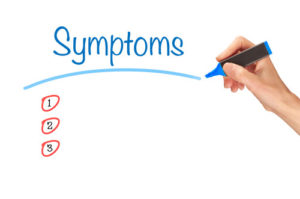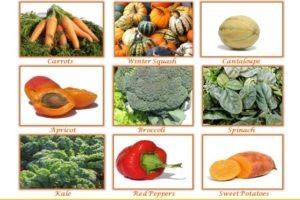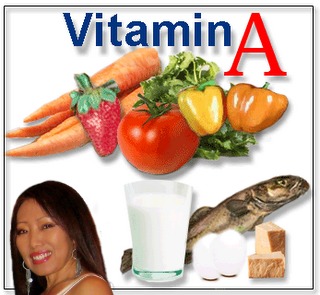Vitamin A is essential for your sight and eye health because it is required for the following two main functions:
- Prevention of xerophthalmia (drying, thickening, and other abnormalities of the cornea and conjunctiva)
- Formation of photoreceptor pigment in the retina (detection and absorption of visible light, vision in darkness or lightness, and immunity of the eye)
Vitamin A is also important for bone growth, proper immune function, reproduction, and the function and maintenance of your heart, lungs, kidneys, and other organs.

Vitamin A deficiency can result from inadequate consumption of vitamin A, fat malabsorption, or liver disorders. Although vitamin A deficiency is supposed to be minimal in developed countries like US, if you experience any of the following symptom(s), you might want to check your vitamin A level:
- Night blindness
- Impaired dark adaptation*
- Macular degeneration
- Retinitis pigmentosa
- Diabetic retinopath
- Ulcers or thinning of the cornea
- Conjunctival deposits
- Grayish spots on eye lining (Bitot sots)
- Impaired immunity
- Weak bones or teeth
- Weak or ridged fingernails
- Repeated infections, especially viral and fungal
- Drying, scaling, and follicular thickening of the skin
- Dry mucous membranes in the GI, respiratory, and urinary tracts
- Thyroid dysfunction
- Chronic inflammation
- Infertility
- Growth retardation and infections among children
(*Note: Impaired dark adaptation could be from severe refractive errors, retinitis pigmentosa, cataracts, or diabetic retinopathy.)
Two Forms of Vitamin A
There are two dietary forms of Vitamin A: preformed Vitamin A and provitamin A.
- Preformed vitamin A (retinol, retinal, retinoic acid, and retinyl esters). Retinol is readily useful to the body and is converted to retinal which helps for vision health and healthy growth of the body cells.
- Provitamin A, also known as carotenoids, is a water-soluble precursor to vitamin A and is found in plant foods. Carotenoids need to be converted into bioavailable retinol to be used as vitamin A. Beta carotene is the most efficient form of carotenoids. The healthy human liver converts 3 IU of beta carotene into 1 IU equivalent of retinol*.
*Note: Diabetics and those with low thyroid function may have difficulty converting beta carotene into retinol. In that case, they might have to get their vitamin A from retinol.
Absorption of Vitamin A is another story
For your body to utilize retinol and convert carotenoids to retinol, you need to have:
- A healthy digestive system – especially liver, gall bladder, pancreas, and small intestines – for optimal digestion and absorption.
- The specific enzymes to break-down the carotenoids to convert it to retinol
Absorption of vitamin A can be difficult if you have …
If you have one of more of the following conditions which interferes with absorption, storage or transport of vitamin A, you might experience vitamin A deficiency:
- Zinc deficiency (Zinc influences absorption, transport, and utilization of Vitamin A)
- Excessive alcohol (adding more problem to the liver where vitamin A is stored)
- Digestive track issues such as Crohn’s disease, IBS, duodenal bypass
- Pancreatic disorder causing enzyme deficiency
- Celiac disease that limit the absorption of nutrients
- Liver disease such as cirrhosis
- Gallbladder disease
- Cystic fibrosis
- Radioiodine treatment for thyroid cancer
- Toxic exposure from cancer treatment and other sources
- Certain prescription drugs
Which Foods Give You Vitamin A?
Most vitamin A is stored in the liver and about five percent of it is used up daily. As such, it needs be replenished by dietary sources.
Animal food sources of retinol

- Fresh, organic and extra virgin cod liver oil
- Liver of organic grass-fed beef, duck, etc.
- organic free-range egg yolks
- Raw organic butter, cheese and milk
Three ounce of beef liver contains 305% of vitamin A; one tablespoon of cod liver oil 272%; one tablespoon of butter 7%; one slice of cheddar cheese 5%; 1 large egg yolk 4%; 1 cup of whole milk 2%; 7 ounce of salmon 1%. Fish oil zero%.
(Note: Vitamin A here means retinol and percent daily values are based on a 2,000-calorie diet. Data from Wikipedia Nutrition Facts.)
You need to be careful when you consume animal sources of Vitamin A as toxicity, acidosis and high cholesterol can occur if excessive quantities are consumed.
Plant based food sources for carotenoids

Green leafy and yellow vegetables and deep- or bright-colored fruits contain good amount of beta carotene as well as lutein, zeaxanthin, phytonutrients, antioxidants, vitamins and minerals.
- Fruits – Cantaloupes, Mango, Apricots, Papaya, Watermelon, Goji berry, Orange
- Vegetables – Carrots, Sweet potatoes, kale, Spinach, Collard greens, Broccoli, Turnip greens, Swiss chard, Butternut squash, Pumpkin, Tomatoes (consume these vegetables with healthy fat such as organic olive oil, butter, nuts, or seeds)
Top source of fruits for carotenoids are cantaloupe, mango, and apricot. For example, one medium size cantaloupe contains 373% of vitamin A, one mango 72%; one cup of sliced apricot 63%.
As for vegetables, 1 medium carrot 203%; 1 cup of sweet potato 377%; 1 cup kale 133%; 1 cup spinach 56%; .1 cup collard greens 36%)
(Note: Vitamin A here means carotenoids and before the conversion to retinol occurs. Percent daily values are based on a 2,000-calorie diet and data obtained from Wikipedia Nutrition Facts. Consume organic produce as much as you can.)
How Much Vitamin A Do You Need?
The recommended daily allowance (RDA) of vitamin A is between 2,310 IU (0.7 milligrams) per day for adult women (more for women who are pregnant or breastfeeding), and 3,000 IU (0.9 milligrams) per day for men, with children needing less as shown below. Data provided by National Institutes of Health. Note that 1 mcg retinol = 3.33 IU.
| 0 to 6 months old | 400 micrograms (mcg) |
| 7 to 12 months | 500 mcg |
| 1 to 3 years | 300 mcg |
| 4 to 8 years | 400 mcg |
| 9 to 13 years | 600 mcg |
| 14 to 18 years | 900 mcg for males, 700 mcg for females |
| 14 to 18 years/pregnant females | 750 mcg |
| 14 to 18 years/breastfeeding females | 1,200 mcg |
| 19+ years | 900 for males, 700 for females |
| 19+ years/pregnant females | 770 mcg |
| 19+ years/breast-feeding females | 1,300 mcg |
Vitamin A toxicity
Holistic Suggestion

Vitamin A is important to your sight, vision health, bone growth, immunity, and many other functions throughout the body as noted above. You can get all of the vitamin A your body needs from a healthy diet alone.
As far as taking vitamin A supplements whether it’s in the form of retinol or beta carotene, be aware that synthetic supplements could add more load to your liver and toxicity to your body. When taken as a supplement, beta-carotene has been associated with increased cancer risk (per International Journal of Cancer 2009).
It’s always a better idea to obtain nutrients from real whole foods. It’s also wise to have a balanced diet including proper amount of macro-nutrients (protein, carbohydrate, and fat) from healthy sources which in addition supply you with good vitamins, minerals and anti-oxidants.
With love and seeing,
Mimi Shekoski, PhD, Natural Vision Teacher | Holistic Natural Health Doctor
References:
cdc.gov/nutritionreport/pdf/Fat.pdf
onlinelibrary.wiley.com/doi/10.1002/ijc.25008/pdf
merckmanuals.com/professional/nutritional-disorders/vitamin-deficiency,-dependency,-and-toxicity/vitamin-a
en.wikipedia.org
ncbi.nlm.nih.gov/pmc/articles/PMC4348990/
en.wikipedia.org/wiki/Retinal_pigment_epithelium
my.clevelandclinic.org/health/articles/night-blindness
ods.od.nih.gov/factsheets/VitaminA-HealthProfessional/
